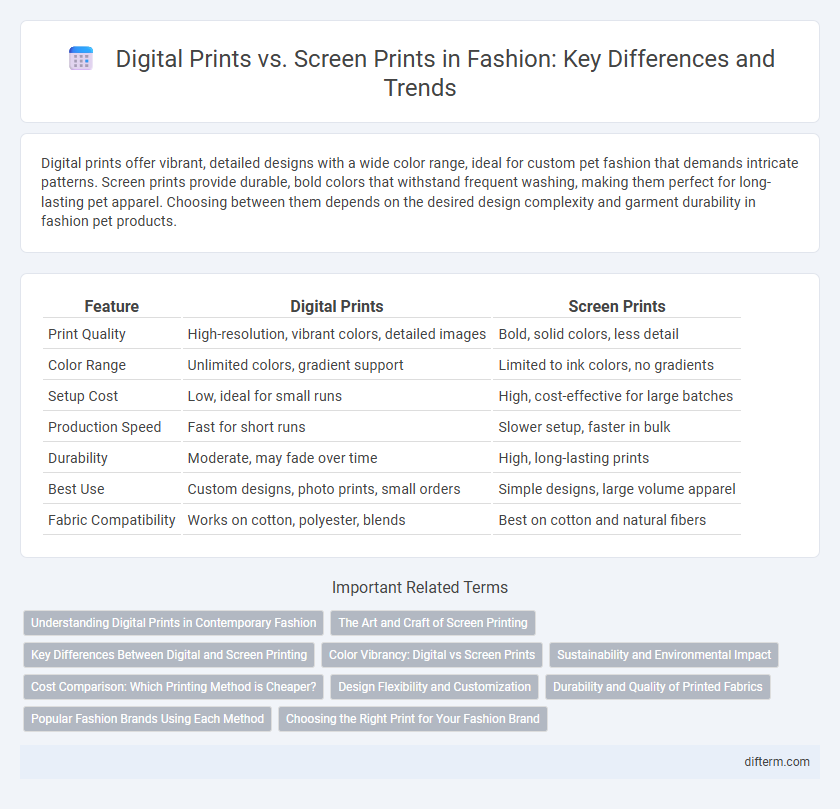Digital prints offer vibrant, detailed designs with a wide color range, ideal for custom pet fashion that demands intricate patterns. Screen prints provide durable, bold colors that withstand frequent washing, making them perfect for long-lasting pet apparel. Choosing between them depends on the desired design complexity and garment durability in fashion pet products.
Table of Comparison
| Feature | Digital Prints | Screen Prints |
|---|---|---|
| Print Quality | High-resolution, vibrant colors, detailed images | Bold, solid colors, less detail |
| Color Range | Unlimited colors, gradient support | Limited to ink colors, no gradients |
| Setup Cost | Low, ideal for small runs | High, cost-effective for large batches |
| Production Speed | Fast for short runs | Slower setup, faster in bulk |
| Durability | Moderate, may fade over time | High, long-lasting prints |
| Best Use | Custom designs, photo prints, small orders | Simple designs, large volume apparel |
| Fabric Compatibility | Works on cotton, polyester, blends | Best on cotton and natural fibers |
Understanding Digital Prints in Contemporary Fashion
Digital prints in contemporary fashion offer unparalleled versatility and precision, allowing designers to produce intricate, full-color patterns directly onto fabric with high resolution. Unlike screen prints, which require separate stencils for each color and are best suited for large, uniform designs, digital prints can easily accommodate complex gradients and photographic imagery. The technology supports rapid prototyping and small batch production, making it ideal for fashion brands seeking to innovate with customizable and limited-edition collections.
The Art and Craft of Screen Printing
Screen printing is a meticulous art form that involves pushing ink through a stencil on a fine mesh screen, allowing for vivid colors and precise details with a tactile texture that digital prints often lack. This craft demands skill and patience, as each color requires a separate screen and layering process, making it ideal for bold, graphic designs on textiles. The durability and vibrant finish of screen-printed garments have made this technique a timeless choice in fashion, marrying traditional craftsmanship with creative expression.
Key Differences Between Digital and Screen Printing
Digital printing offers detailed, full-color designs with rapid turnaround and is ideal for small orders due to its minimal setup costs. Screen printing excels in producing vibrant, durable prints with rich ink saturation, making it cost-effective for large volume runs and designs with fewer colors. The choice between digital and screen printing depends on design complexity, order size, color requirements, and budget constraints.
Color Vibrancy: Digital vs Screen Prints
Digital prints offer exceptional color vibrancy with the ability to reproduce millions of shades and intricate gradients directly onto fabric, resulting in vivid and detailed designs. Screen prints provide bold and durable colors, but their vibrancy is limited by the number of ink colors and layering techniques used. While screen printing excels in producing solid, intense hues, digital printing leads in capturing complex color variations and photo-realistic images on fashion textiles.
Sustainability and Environmental Impact
Digital prints in fashion minimize water usage and chemical waste compared to traditional screen prints, significantly reducing environmental impact. Screen printing often relies on plastisol inks containing PVC and heavy metals, which contribute to toxic runoff and landfill pollution. Sustainable fashion brands increasingly favor digital printing for its lower carbon footprint and ability to produce on-demand, reducing fabric waste.
Cost Comparison: Which Printing Method is Cheaper?
Digital prints generally offer a lower upfront cost compared to screen prints, making them more cost-effective for small orders and custom designs in the fashion industry. Screen printing becomes more economical for large volume runs due to its scalability and lower per-unit cost after setup expenses. Brands must weigh initial investment against order size to determine the cheaper printing method for apparel production.
Design Flexibility and Customization
Digital prints offer unparalleled design flexibility, allowing for intricate, multi-colored patterns and photographic details without extra cost or setup time. Screen prints excel in vibrant, durable colors but are limited by the number of colors and require separate screens for each design element, restricting customization. Brands seeking rapid design changes and complex visuals favor digital printing, while those prioritizing cost-effective bulk production often choose screen printing.
Durability and Quality of Printed Fabrics
Digital prints on fabrics offer vibrant color accuracy and intricate design details, maintaining clarity after multiple washes due to advanced ink technology. Screen prints deliver superior durability with thicker ink layers, making them highly resistant to fading and cracking over time, especially on heavier fabrics. Choosing between the two depends on the desired balance of fine detail and long-lasting wearability in fashion textiles.
Popular Fashion Brands Using Each Method
Popular fashion brands like Nike and Adidas often favor digital prints for their ability to produce vibrant, intricate designs with quick turnaround times, enhancing customization and limited edition releases. In contrast, luxury labels such as Gucci and Versace frequently utilize screen printing to achieve bold, long-lasting colors and textures, ideal for high-end fabric applications with rich detail. Both methods offer distinct advantages that align with brand identity and production needs, making them strategic choices in fashion manufacturing.
Choosing the Right Print for Your Fashion Brand
Digital prints offer intricate designs and vibrant colors with faster turnaround times, ideal for brands seeking customization and small runs. Screen prints provide durability and cost-efficiency for large-volume orders, making them suitable for classic, bold graphics in fashion. Selecting the right printing method depends on your brand's design complexity, budget, and production scale.
Digital prints vs screen prints Infographic

 difterm.com
difterm.com